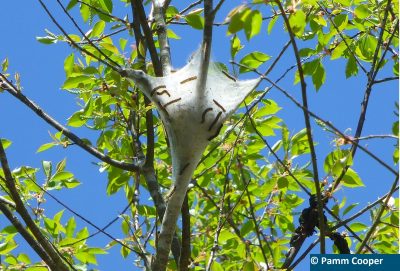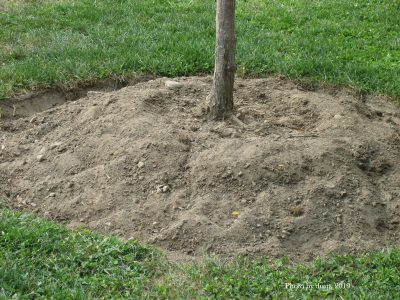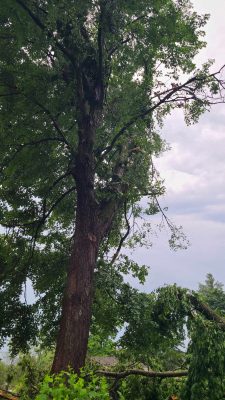By Pamm Cooper, UConn Home & Garden Education Center This spring has been a dramatic one as ornamental trees and shrubs are putting on quite a colorful floral display. Many deciduous ornamentals including redbuds, forsythia, crabapples, fruit trees, quince azaleas and many others were not adversely affected by last summer’s drought and the cold, windy winter and frozen soils that followed. A lesser noticed but significant drama is the negative effect these same environmental conditions had on ornamental and native evergreens.
Rhododendrons and ‘Green Giant’ arborvitae seemed to suffer the most damage followed by cherry laurels and hollies. Last year’s drought conditions that extended into late fall combined with very windy winter conditions and frozen soils were tough for some evergreens. Winter desiccation injury on broadleaved and needled evergreens causes foliage browning when plants cannot take up the water needed to keep foliage healthy. Damage to many rhododendrons and some azaleas could be seen during the winter and is still evident this spring. Buds may provide new leaves by June if branches are still alive.
In contrast, 'Green Giant’ arborvitaes suddenly showed symptoms after warm weather began this spring. This was evident especially in trees on windy sites. Needles are brown or off color and time will tell if they are able to recover. If branch tips are flexible and show new buds, growth may resume. Prune any dead branches that show no signs of recovery.

Eastern tent caterpillars have hatched from overwintering egg masses on native black cherries. Silken nests are evident located in crotches of these trees. Caterpillars feed outside the tents at night and hide in them during the day. There is only one generation, and feeding is generally finished by late June. Trees have time to leaf out again to remain healthy during the growing season. Birds like cuckoos and vireos will rip tents apart to feed on the caterpillars.
If you have Oriental lilies, be alert for the lily leaf beetle. This bright red insect can severely defoliate these lilies. Adults overwinter in soil close to the plants they were feeding on the previous season. They appear as soon as lilies begin new growth above the ground. Leaf undersides should be checked for eggs and larvae and crushed when found. Leaves can be treated if needed with a product that larvae will ingest as they feed on the treated leaves. Never spray flowers with any insect control product and always follow directions as written on the product label.
Snowball aphid feeding damage is noticeable on the new leaves of European cranberry bush and snowball viburnums. As the aphids feed on the new leaves and twigs, leaves curl and twigs twist in response to aphid feeding on the sap. Aphids can be found by uncurling the leaves. Treatment is difficult as they are not out in the open where contact control products can reach them. Feeding should end within two months of egg hatch. These aphids overwinter as eggs laid on the branches of host viburnums.
Viburnum leaf beetles, Pyrrhalta viburni, are another significant pest of ornamental and native viburnums. They’re active soon after viburnums leaf out. Damage will be seen as larval populations grow and they skeletonize leaves. Some viburnums may suffer complete defoliation. This pest prefers arrowwood, European cranberry bush or American cranberry bush viburnums. Try switching to resistant varieties such as V. plicatum and Korean spicebush viburnum V. calesii if leaf beetles are a chronic pest.
If anyone has small St John’s wort shrubs or certain weigela cultivars that seem to be dead, wait and see if new growth resumes as it gets warmer and sunnier. The smaller St. Johns’ wort shrubs die back in fall, leaving brown stems with withered fruit. Prune these back almost to the ground as basal growth appears. Some weigela cultivars are just slowly getting started, while others are already full of leaves. Do not give up these plants but wait and see what happens in May.
As always, our UConn Home and Garden Education Center office staff welcomes any questions gardeners may have concerning landscape and garden plants problems. Across the New England region, people are having much the same problems as we are having in Connecticut from the winter weather, but we can hope that plant recovery be swift and complete. Enjoy the growing season and stay alert- scout for pests and other problems before they get out of hand.
The UConn Home & Garden Education Center supports UConn Extension’s mission by providing answers you can trust with research-based information and resources. For gardening questions, contact us toll-free at (877) 486-6271, visit our website at homegarden.cahnr.uconn.edu, or reach out to your local UConn Extension center at cahnr.uconn.edu/extension/locations.
This article was published in the Hartford Courant May 10, 2025



